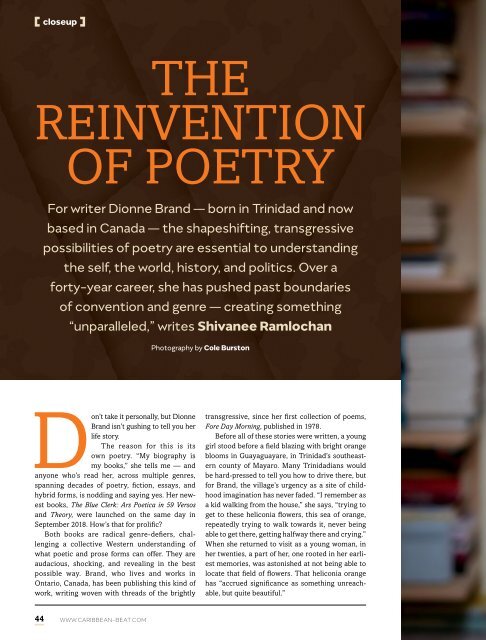Caribbean Beat — September/October 2019 (#159)
A calendar of events; music, film, and book reviews; travel features; people profiles, and much more.
A calendar of events; music, film, and book reviews; travel features; people profiles, and much more.
You also want an ePaper? Increase the reach of your titles
YUMPU automatically turns print PDFs into web optimized ePapers that Google loves.
closeup<br />
The<br />
reinvention<br />
of poetry<br />
For writer Dionne Brand <strong>—</strong> born in Trinidad and now<br />
based in Canada <strong>—</strong> the shapeshifting, transgressive<br />
possibilities of poetry are essential to understanding<br />
the self, the world, history, and politics. Over a<br />
forty-year career, she has pushed past boundaries<br />
of convention and genre <strong>—</strong> creating something<br />
“unparalleled,” writes Shivanee Ramlochan<br />
Photography by Cole Burston<br />
Don’t take it personally, but Dionne<br />
Brand isn’t gushing to tell you her<br />
life story.<br />
The reason for this is its<br />
own poetry. “My biography is<br />
my books,” she tells me <strong>—</strong> and<br />
anyone who’s read her, across multiple genres,<br />
spanning decades of poetry, fiction, essays, and<br />
hybrid forms, is nodding and saying yes. Her newest<br />
books, The Blue Clerk: Ars Poetica in 59 Versos<br />
and Theory, were launched on the same day in<br />
<strong>September</strong> 2018. How’s that for prolific?<br />
Both books are radical genre-defiers, challenging<br />
a collective Western understanding of<br />
what poetic and prose forms can offer. They are<br />
audacious, shocking, and revealing in the best<br />
possible way. Brand, who lives and works in<br />
Ontario, Canada, has been publishing this kind of<br />
work, writing woven with threads of the brightly<br />
transgressive, since her first collection of poems,<br />
Fore Day Morning, published in 1978.<br />
Before all of these stories were written, a young<br />
girl stood before a field blazing with bright orange<br />
blooms in Guayaguayare, in Trinidad’s southeastern<br />
county of Mayaro. Many Trinidadians would<br />
be hard-pressed to tell you how to drive there, but<br />
for Brand, the village’s urgency as a site of childhood<br />
imagination has never faded. “I remember as<br />
a kid walking from the house,” she says, “trying to<br />
get to these heliconia flowers, this sea of orange,<br />
repeatedly trying to walk towards it, never being<br />
able to get there, getting halfway there and crying.”<br />
When she returned to visit as a young woman, in<br />
her twenties, a part of her, one rooted in her earliest<br />
memories, was astonished at not being able to<br />
locate that field of flowers. That heliconia orange<br />
has “accrued significance as something unreachable,<br />
but quite beautiful.”<br />
44 WWW.CARIBBEAN-BEAT.COM

















